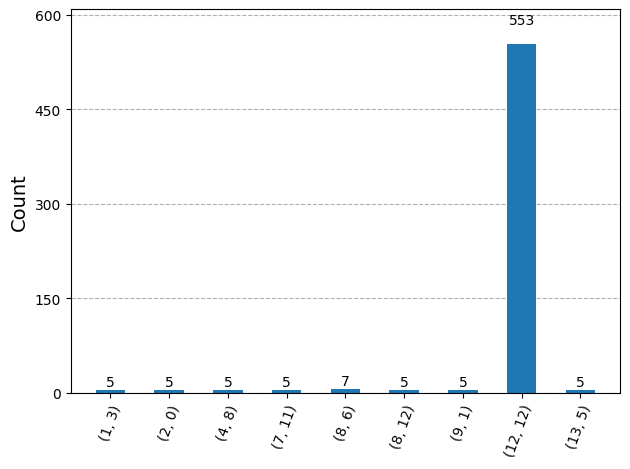Grover search: hash function preimage attack
In the ever-evolving landscape of cybersecurity, the advent of quantum computing presents both an extraordinary opportunity and an unprecedented challenge. In this notebook we exploit a Grover Search to perform a preimage attack on a toy hash function.
A preimage attack on a cryptographic hash function h(m) tries to find a message m that has a specific hash value. Using qlasskit it is easy to write an hash function like the following hash_simp:
from qlasskit import qlassf, Qint, Qint8, Qlist
@qlassf
def hash_simp(m: Qlist[Qint[4], 2]) -> Qint[8]:
hv = 0
for i in m:
hv = ((hv << 4) ^ (hv >> 1) ^ i) & 0xFF
return hv
Thanks to the fact that qlasskit function are standard python functions, we can call the original_f to perform some kind of analysis on the hash function. Since the input space is tiny (it is a toy hash function), we can detect if the hash function is uniform (if it maps equally to the output space).
from collections import Counter
d = Counter(hex(hash_simp.original_f((x, y))) for x in range(2**4) for y in range(2**4))
print("Hash function output space:", len(d))
Hash function output space: 256
We got that hash_simp is following an uniform distribution.
hash_simp.export("qiskit").draw("mpl")

Now we use our quantum function as an oracle for a Grover search, in order to find which input maps to the value 0xca.
from qlasskit.algorithms import Grover
q_algo = Grover(hash_simp, Qint8(0xCA))
Then we use our prefered framework and simulator for sampling the result; this is an example using qiskit with aer_simulator.
from qiskit import QuantumCircuit, transpile
from qiskit.visualization import plot_histogram
from qiskit_aer import AerSimulator
qc = q_algo.export("qiskit")
qc.measure_all()
simulator = AerSimulator()
circ = transpile(qc, simulator)
result = simulator.run(circ).result()
counts = result.get_counts(circ)
counts_readable = q_algo.decode_counts(counts, discard_lower=5)
plot_histogram(counts_readable)

Using QlassF.original_f we can double check the result without invoking a quantum simulator; calling it with the tuple (12,12) must result in the hash value 0xca.
print(hex(hash_simp.original_f((12, 12))))
0xca